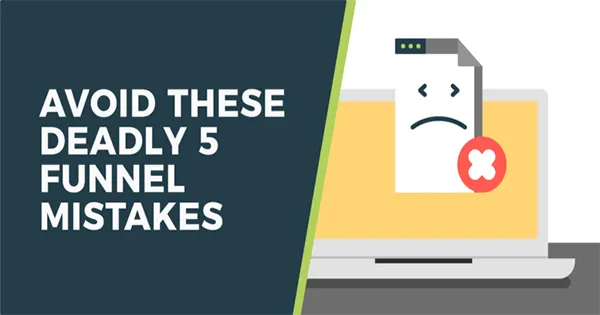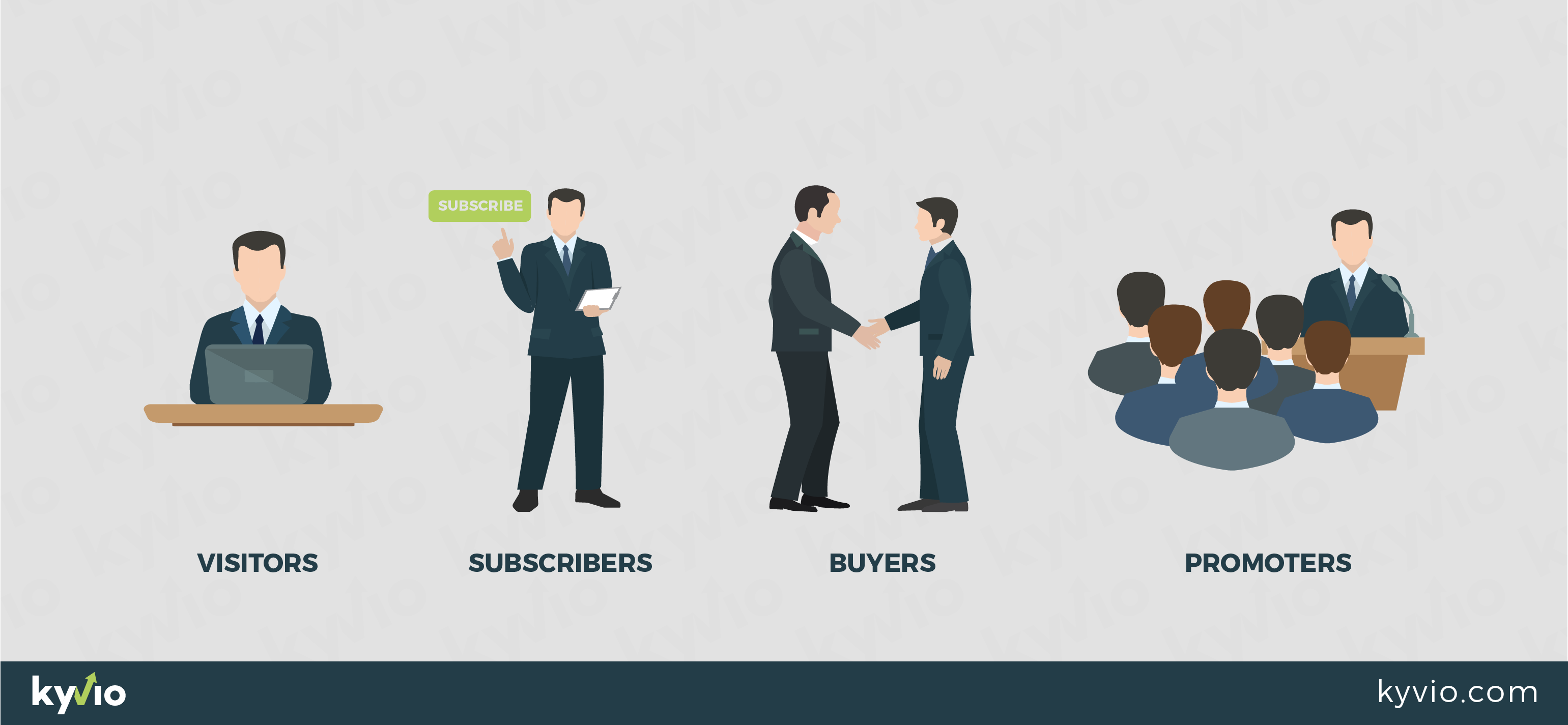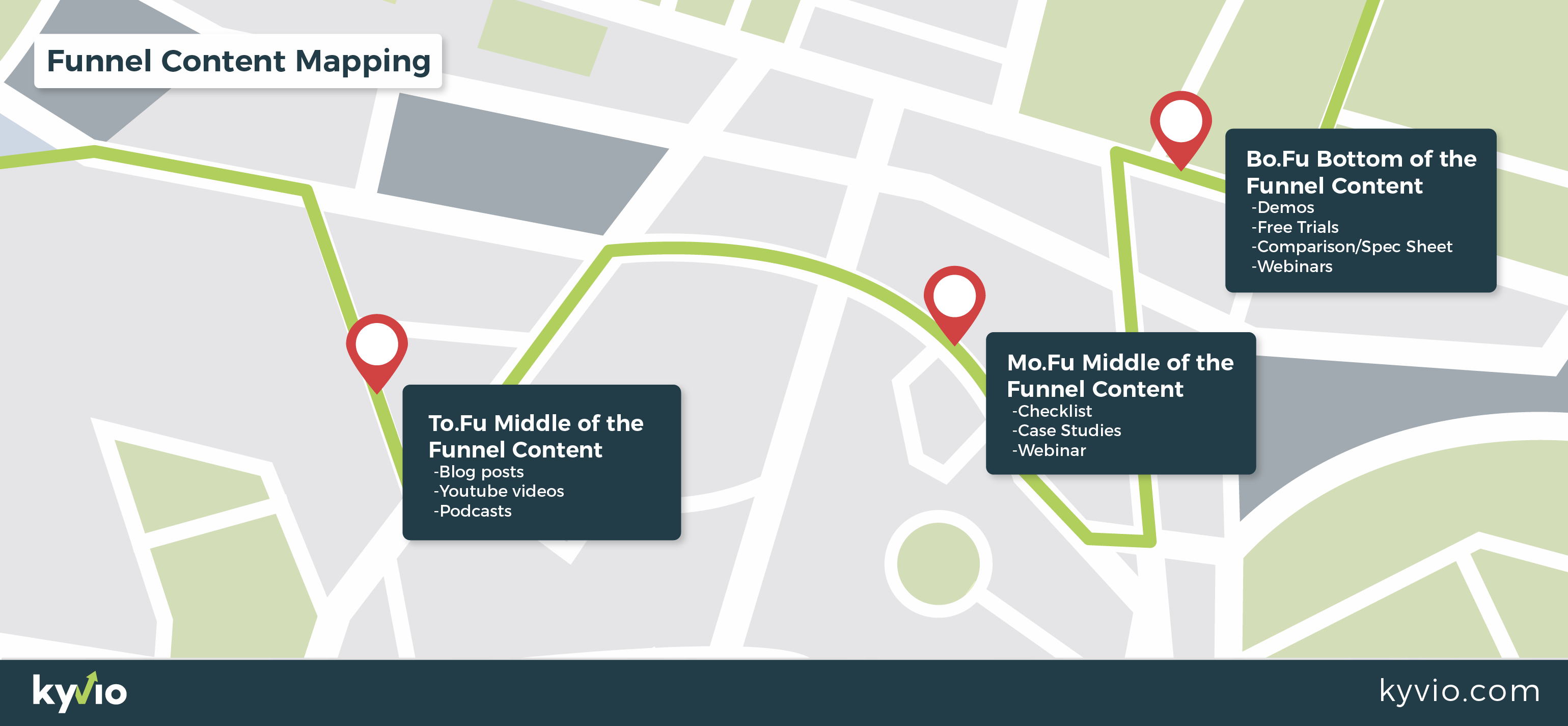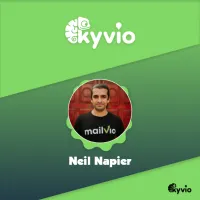Kyvio Blog

5 Mistakes That Are Hurting Your Funnel Conversion
Every business already has some sort of process in place to generate leads, convert them to prospects and then to customers. That process is a funnel. It does not matter whether you are running an online business or a brick and mortar store. Without a funnel in place, your business will struggle to grow.
A sales funnel is a series of steps designed to help prospects move up your value ladder. Prospects go from being website visitors to subscribers to purchasing your product (or service) all the way to becoming brand advocates.

There are several benefits to implementing a sales funnel into your business. Even though it might not be properly defined, chances are you already have some sort of funnel in place already. Once you create and launch your funnel, you can expect the following benefits:
A sales funnel provides a methodical and well-organized approach to building your business. Everything from acquiring prospects to converting them into customers is all laid out in an easy-to-follow format.
A sales funnel will increase your company’s revenue. By having up-sell and cross-sell pages, you dramatically increase your potential earnings per customer. The best part is with tools like Kyvio, you can automate the entire process.
A sales funnel can help you predict your monthly sales. Thanks to analytics, you have access to every data possible. You can use these data to track your funnel conversion at every stage. This helps you paint a good picture you can benchmark your revenues against.
Even though sales funnels are great, not everyone will enjoy their benefits. The reason is simple, not every funnel is properly optimized for conversions. This article explores five of the most common mistakes affecting your funnel conversion.
Mistake #1 – Your Offer is Weak
Trying to sell a weak offer is one of the most common mistakes entrepreneurs make to their funnels conversion. A weak offer is not a bad product or service, it is rather trying to sell your most expensive product right off the bat. Most people are not ready to buy when they first enter your funnel. And those who are ready to buy would rather buy a low-cost product to see your value offering.
The solution is simple. Instead of trying to sell a product, sell an offer. This is where tripwire offers come into place. A tripwire offer is a low-cost “splinter” off your main product or service. It is meant to help you build a “buyer’s list” instead of just an email list. Chances are when prospects buy your tripwire, they will be more likely to buy your high-ticket offers too.
Mistake #2 – You Are Targeting The Wrong Audience
Another common mistake that hurts your funnel conversion is trying to sell to the wrong audience. Your marketing will be ineffective when you lack a clear understanding of your ideal customer.
You need to know everything about your customers. Everything from their pain-points to their aspirations is crucial data you can leverage. When you’re armed with such information, you will write better copy and run better Facebook ads. Your landing pages will also convert better.
RELATED: Your Guide To Creating High Converting Multiple Step Funnels
Unfortunately, many entrepreneurs focus on filling up their funnel as quickly as possible. They do this by trying to appeal to everyone with their marketing messages. There are two major reasons why this is a bad idea:
It is expensive: Trying to appeal to everyone with your marketing will reflect on your ad spend. You will end up spending more money because your targeting is too broad.
It is time-consuming: Not only will your ad spend be sky high, you will also attract unqualified leads. So, instead of nurturing your leads, you will end up spending the time to segment them.

So what is the solution?
Create a buyer persona and strictly align your marketing copy to it.
Avoid casting your proverbial marketing net too wide with your paid ads. Narrow down your focus instead.
Focus time and money on long tail keywords with your SEO efforts.
Only nurture qualified leads and unsubscribe unqualified, freebie-seekers.
When you use these tips, you will be attracting people who are more likely to convert. Remember, the quality of the leads entering your funnel is more important than the quantity when it comes to funnel conversion.
Mistake #3 – Your Design and Copy Are Not Attractive
As you know, a funnel is a series of steps designed to move a prospect towards the sale. And usually, the doorway into your funnel is your landing page.
The landing page could either be to access a lead magnet or to purchase a tripwire offer. Whatever the case may be, it all starts with a landing page. While there are several elements that make a landing page effective, at the core are three basic components. These are:
The Design
The Copy
The Call To Action
The Design
The first thing anyone who visits your landing page notices is the design. You need to make sure there are no distractions. Use colors to draw attention to important sections of your page, such as the headline and the call-to-action (CTA). You should also use a lot of whitespace in order for the text to stand out. Finally, avoid any unnecessary clutter such as navigation menus and fancy graphics that add no value.
The Copy
You need to be able to quickly capture your reader’s attention within the first few seconds of landing on your page. The most important copy on your landing page is the headline. It must spark their curiosity and make them want to keep reading the entire page. The body of your message should be straightforward and only focus on the benefits of your offer and not the features.
The Call To Action
Whatever you want your website visitors to do after reading your landing page should be clearly articulated with your CTA. A good call-to-action should be actionable and bold. Use bold colors to effectively highlight your CTA button. Additionally, let the button clearly state what the website visitor will get when they click. For example, “Download My Free Ebook” is a better CTA than a “Download Now” button.
Mistake #4 – Your Funnel is Not Properly Mapped Out
Another mistake business owners make is with the funnel itself. Most businesses do not have a clearly defined sales funnel. As a matter of fact, only about 68% of businesses do. You are inadvertently hurting your funnel conversion if your funnel is not properly mapped out.
Not only should your funnel be mapped out, but it should also be clear and simple. Otherwise, you risk losing potential customers who will find your steps too confusing. Your goal is to make the process from lead to customer in your funnel to be as quick (and frictionless) as possible.
Listed below are some tips that will help you optimize your funnel and improve your funnel conversion:
Use storytelling to capture your leads attention and lead them down into your funnel
Limit the number of steps in your funnels and remove all unnecessary distractions
Use heat maps to identify areas of your site that are hurting your funnel conversion
In addition, you should consider tailoring your content towards specific stages in your funnel. That means you should have top of the funnel content (ToFu), middle of the funnel content (MoFu) and bottom of the funnel (BoFu) content. All of these should work together to help prospects advance to the next step in your funnel and enhance your funnel conversion.

Mistake #5 – You Do Not Follow-Up with Leads
Not following up with your leads is a very costly mistake. If someone shows interest by entering your funnel, you are literally leaving money on the table by not engaging with them.
It is true that not every lead is ready to convert the moment they enter your funnel. However, 80% of them are ready to convert after having multiple touch points with your company. These touchpoints will mostly be through email marketing campaigns. Social media and blog posts will also play a part in achieving that.
It is important to note that your content shouldn’t be sales-y. Instead, you must focus on building a relationship with your leads. You need to be authoritative, informative and helpful. Your audience should feel like you actually care more about them than you are about making a sale.
Pro Tips:
Set up email drip sequences that will move prospects towards the end of your funnel
Use analytics to monitor your email campaigns
Segment ToFu, MoFu & BoFu content to correspond to prospect’s journey
Use a robust software (such as Kyvio) to manage your funnel(s).
It is important to note that the software you choose must have a content management system, an email marketing tool, analytics, and a page builder. This makes it easy to handle every aspect of your funnel without the need for countless integrations.
Conclusion
A sales funnel is one of the most important elements to growing any business online. In fact, the success (or otherwise) of your online business relies on the efficiency of your funnel. If your funnel is properly optimized for conversions, your business will thrive.
Software such as Kyvio makes the entire process of optimizing your funnel a breeze. From building landing pages to delivering content to email automation, an all-in-one sales funnel software will help you turn your funnel into a conversion machine.



